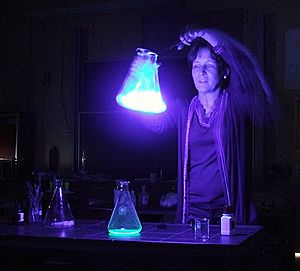Chemiluminescence facts for kids
Chemiluminescence (say "kem-ee-loo-min-ESS-ense") is a cool way that light is made from a chemical reaction. Think of it like science magic! This light is not made by heat, which is different from how a light bulb works. When this process happens in living things, like fireflies, we call it bioluminescence.
Contents
How Light is Made
In chemiluminescence, chemicals mix and create energy. This energy pushes tiny parts of atoms called electrons to a higher energy level. We call this an "excited state."
But electrons don't like to stay excited for long! They quickly fall back to their normal, lower energy level (called the "ground state"). When they fall, they release the extra energy as light. This is how the glow happens!
The amount of light we can measure is called "radiant intensity." It tells us how many tiny light particles, called photons, are sent out every second.
Using Chemiluminescence
Scientists use chemiluminescence in many ways to find and measure different substances. The equipment needed to see this light is quite simple. It usually involves a container for the chemicals and a special camera-like device called a photomultiplier tube.
Here are some ways it's used:
- Sometimes, the substance a scientist wants to find will glow when it reacts with another chemical.
- In other cases, the amount of light produced by a reaction might drop when a certain substance is added.
- Sometimes, adding a substance can make a chemiluminescent reaction produce even more light. This is like a helper that boosts the glow!
Examples of Chemiluminescence
You might have seen chemiluminescence in action without even knowing it!
- Fireflies: One of the best natural examples is the light made by fireflies. They use a special molecule called luciferin to create their famous glow. This is a type of bioluminescence.
- Glow Sticks: The fun, colorful glowsticks you use are a perfect example of chemiluminescence. Inside, two different chemicals mix when you snap the stick. This creates a reaction that makes light without any heat!
Images for kids
-
Bioluminescence in nature: A male firefly mating with a female of the species Lampyris noctiluca.
-
Chemiluminescence after a reaction of hydrogen peroxide and luminol
See also
 In Spanish: Quimioluminiscencia para niños
In Spanish: Quimioluminiscencia para niños





